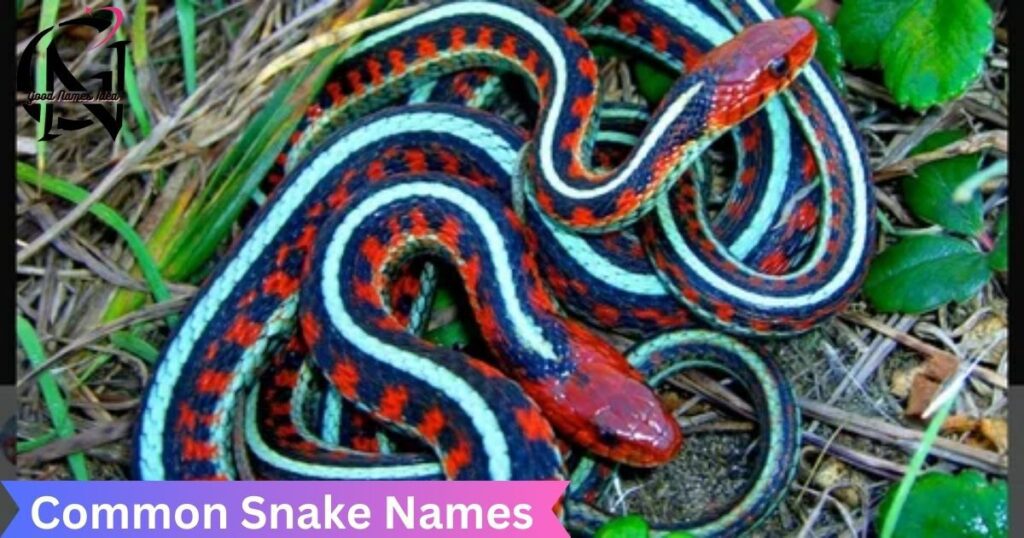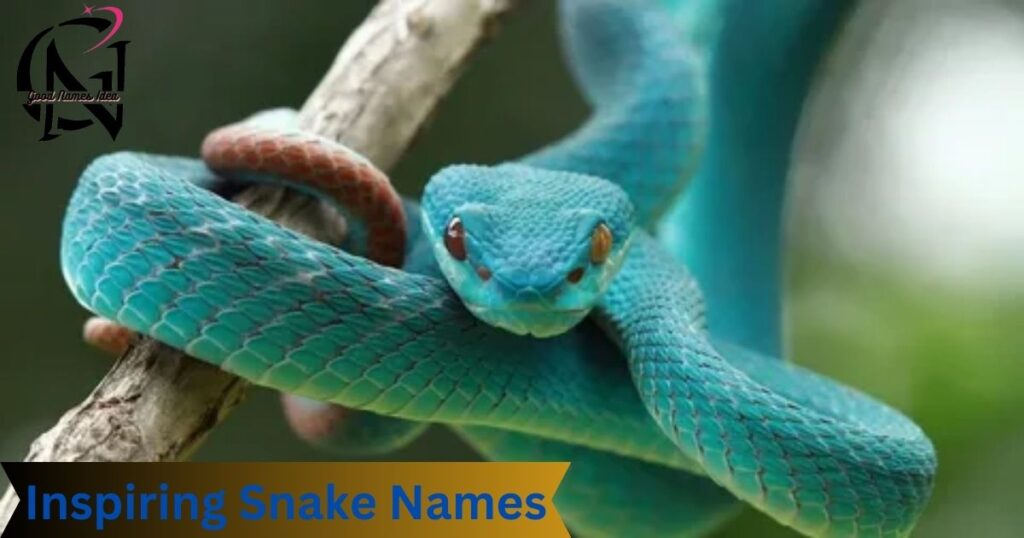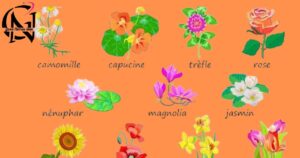Snake Names is a captivating concept that links reptilian labels to human character. From regal Cobras to cunning Vipers, these serpentine sobriquets unveil hidden traits, inviting you to embrace your inner serpent. Whether you’re a Pythonic planner or a Mamba maestro, this unique idea offers a playful and insightful way to discover a name that speaks to your soul.
Names for Every Personality
| Personality Type | Corresponding Name |
| Ambitious | Onyx |
| Nurturing | Willow |
| Analytical | Quartz |
| Adventurous | Ember |
| Imaginative | Sapphire |
| Dependable | Granite |
| Passionate | Saffron |
| Curious | Topaz |
| Resilient | Obsidian |
| Harmonious | Pearl |
Top 350 Unique Snake Names: Meanings, Origins, and More!
Anaconda – Large snakes found in South America. Means “one that cannot be overcome.”
Asp – Small venomous snake found in parts of Africa and Asia. Known for causing asps in Greek mythology.
Atticus – A Latin name meaning “man from Attica.”
Basilisk – A mythical serpent reputedly able to cause death with a glance. Named after the basilisk lizard.
Boa – Large constrictor snakes found in tropical parts of the Americas. Means “rain” in Portuguese.
Biting Betty – Fun play on the idea of a snake that likes to bite.
Brick – Nickname suggests toughness and strength like a brick house.
Bronx – A borough of New York City known for its grittiness.
Bruno – Italian name meaning “brown.” Fits many brown-colored snake varieties.
Cairo – Exotic name of the capital city of Egypt where many snake species are found.
Calypso – A sea nymph who kept Odysseus captive with her singing on the Greek island of Ogygia.
Cassandra – In Greek mythology, she was cursed by Apollo never to be believed when she told the future.
Castor – In Greek mythology, one of the Gemini twins whose constellation resembles two entwined serpents.
Cerberus – In Greek mythology, the multi-headed dog that guarded the entrance to the underworld.
Charmer – Refers to the legendary ability of snakes to hypnotize prey with their stare.
Cleo – Short form of Cleopatra, the famous Egyptian queen and snake charmer.
Cleopatra – Famous Egyptian queen who allegedly used asps to commit suicide.
Copper – Refers to the reddish hue of some snake species. Can also mean crafty like a copperhead.
Cottonmouth – Species also known as water moccasin with characteristic cotton-like gray interior mouth.
Crypto – Shortened version of cryptozoology, the study of legendary creatures.
Darwin – Honors Charles Darwin who studied snakes and their evolution in his travels.
Demeter – Greek goddess of harvest and sacred to snakes. Her followers handled snakes as part of rituals.
Desi – Hindi name meaning “from the land” to represent a native snake.
Diamond – Glitters like the precious gemstone. Can also refer to diamond-patterned skin.
Django – A Romany jazz guitarist who moves with his own rhythm, like a snake.
Draco – A type of flying dragon in Greek mythology that was later called a basilisk that could walk, run, or sail through the air.
Eden – The serpent in the Garden of Eden in biblical stories. Represents temptation.
Elphaba – The “Wicked Witch of the West” from Wicked who uses snakes as a symbol of rebellion.
Emerald – Vivid green gemstone that evokes the coloration of some venomous snakes.
Enyo – Greek goddess of war, strife, and bloodshed who was sometimes depicted as serpent-haired.
Euryale – A venomous gorgon sister in Greek myth with hair of living, interlaced serpents.
Ezra – Hebrew name meaning “helper” or having “helped” connecting to the role snakes play in medical research.
Falcon – Refers to swift striking and movement like the raptor bird of prey.
Fern – The snake’s slender body can resemble the delicate green plant’s stalks and fronds.
Gabriel – Means “God is my strength” in Hebrew. Represents power and divinity associated with snakes.
Gaia – The goddess personifying the Earth in Greek mythology sometimes seen with serpents.
Galatea – A beautiful sea nymph sculpted from marble who came to life after being kissed by Pygmalion’s statue.
Garter – Type of nonvenomous North American snake often seen near wetlands.
Hydra – Many-headed serpent slain by Heracles as one of his twelve labors in Greek myth.
Iago – The evil, manipulative character from Shakespeare’s Othello who is cunning and crafty like a snake.
Indigo – Deep blue dye and color of twilight skies similar to shades of snakeskin patterns.
Izzy – Unisex nickname referring to snakes like adders that cause irritation from their venom.
Jasper – Jewel that comes in variegated colors and patterns like many snakes.
Jet – Glossy black gemstone evoking the inky darkness of a shadowy snake.
Kaa – The hypnotic Indian python from Rudyard Kipling’s The Jungle Book.
Kali – Hindu goddess sometimes depicted with fangs, serpents, and a garland of skulls.
Kukulkan – The plumed serpent god of the Maya civilization; feathered serpents.
Luna – Moon goddess in Roman mythology, often associated with snakes due to their shedding skin cycles.
Mamba – Black mamba of Africa, one of the most lethal and fastest snakes.
Medusa – Mythical Greek creature whose hair was a mass of venomous snakes used to turn onlookers to stone.
Mercury – Messenger to the gods, speedy plant, and metallic symbol for medicine often associated with snakes.
Midgard – In Norse mythology, a giant serpent encircles the Middle Earth realm Midgard.
Misty – Ethereal namesake of snakes that seem to appear and disappear like mist.
Mongoose – Small carnivorous mammal in parts of Asia and Africa that is a natural enemy of snakes.
Muamba – Congo word for “snake spirit” connecting snakes to witchcraft beliefs.
Muse – Refers to how snakes embody mystery and intrigue in different cultures through mythology.
Naja – Genus that includes the Indian cobra and other highly venomous Asiatic cobras.
Nandal – Name of the naga (half-human, half-serpent beings) king of wealth and treasure in Hindu epics.
Napa – Valley in northern California known for its wineries; Napa valley kingsnake subspecies.
Nari – One of the mother goddesses of Hindu belief who sometimes takes the form of snakes.
Nidhogg – Giant serpent that gnaws at the roots of the tree Yggdrasil in Norse legends.
Nija – Swahili word for cobra and other venomous snakes found across eastern and southern Africa.
Nike – Greek goddess of strength, speed, victory who carries a serpent Aglauros as her emblem.
Nimbus – Name meaning “rain cloud,” symbolic of snakes’ ability to shed their skins.
Ningyo – Japanese word for mermaid; their twisting form resembles snakes emerging from water.
Noire – French for “black” like the obsidian coloration of melanistic snakes.
Ophidian – Relating to serpents in general from the Greek “ophis” meaning snake.
Ophiuchus – A man holding a snake above his head who is one of the 88 modern constellations.
Ophelia – Character from Shakespeare’s Hamlet who drowns herself with flower garlands; associated with snakes.
Ouroboros – Mythical serpent that eats its own tail; a symbol of infinity, cyclicality.
Panda – Suggests contrasting patterns as in panda coloration.
Persephone – Greek goddess associated with serpents as daughter of the earth Demeter.
Poseidon – God of the sea who is sometimes connected to or depicted with serpents.
Puck – Mischief-maker from Shakespeare’s A Midsummer Night’s Dream reminiscent of crafty snakes.
Pylades – Devoted friend to Orestes in Greek legend; rarely left each other’s side, as in bonded pairs of snakes.
Python – Monster slain by Apollo in Greek myth; the name of the snake is still used today.
Quetzalcoatl – Aztec “feathered serpent” god of creation, light, wisdom, and wind.
Rain – Fitting name for the hydrophilic, water-loving nature of many snakes.
Rattler – Common name referring to rattlesnakes’ frightening noise and tail defensive mechanism.
Rex – Means “king” suggesting grandeur and power as rulers of the reptile world.
Rhine – River that snakes through central Europe, associated with mysterious legends.
Rosalind – Jungle book character who taught Mowgli about snakes in a benign way.
Rosanna – Means “rose” or “little rose;” some snakeskin like delicate rose petals.
Saffron – Spice with golden hue mirroring some snakes’ brilliant coloring.
Salazar – Spanish and Portuguese name derived from Roman “Salvius” meaning “savior.”
Samurai – Elite warriors of feudal Japan who saw snakes as symbols of strength/longevity.
Sapphire – Gem with the same deep blue color as many snakes.
Sassy – Playful name for any lively snake with attitude.
Scorpio – Constellation representing a scorpion, a deadly arachnid cousin of snakes.
Serpent – The serpent from Genesis who tempted Eve in the biblical story of the
Hemlock – Poisonous plant of northern forests paralleled by venomous water snakes and viper species.
Hyacinth – Fragrant lilac flower and gem hue like garter snakes’ stripes.
Indigo – Dark blue plant dye matching their skin shade or vivid marks.
Ivy – Everbushy climbing plant resembling snakes coiling up tree trunks and branches.
Jade – Green semi-precious stone coloration found in many arboreal snakes.
Juniper – Pine shrub with wispy branches framing snakes’ scales.
King Cobra – Largest of all venomous snakes native t
o forests of Southeast Asia.
Lapis – Jewel-toned blue reminiscent of coastline sea snakes.
Laurel – Traditional symbol of achievement and victory as snakes prevail in nature.
Lilac – Pallid purple blossom color seen in few snake morphs.
Mauve – Soft, muted purple-pink shared by flowers and subtropical snakes.
Moss – Soft plant filling in forest floors where snakes travel discreetly.
Nestor – Name of one of Odysseus’ crews in The Odyssey displaying leadership.
Nile – Iconic African river habitat for Egyptian cobras and other aquatic snakes.
Nirvana – Spiritual term for utmost peace found through snakes in some religions.
Nori – Type of edible seaweed like the texture of snakeskin.
Nutmeg – Warm brown spice reminiscent of gopher/pine snakes with autumn chips.
Obsidian – Volcanic glass with reflective gloss like snakes’ raven-black eyes.
Olive – Green-toned fruit color found in grass snakes and others amid brush.
Onyx – Striated variety of chalcedony reflecting banded kraits and corals.
Orchid – Exotic blooms with shapes mimicking mamba flaring their necks in threat posture. Plum – Skin tone of some Asian water snakes swimming in rivers.
Poppy – Crimson flower like the red mist python of rainforests.
Prairie – Wide-open habitat of North America inhabited by bull snakes and rat snakes.
Puka – Type of large sea snail from Hawaii where sea snakes also dwell in reefs.
Quartz – Crystalline form found in mountain stream beds where water snakes bask.
Rainier – Mt. Rainier in the Cascade Range of Washington state with resident snakes.
Raven – Sable black bird shared by few melanistic black snakes.
Reed – Wetland plant perfect for camouflaging water snakes as they float.
Royal – Regal python or king cobra capturing their dignified beauty and size.
Ruby – Bright gemstone evoking vibrant coral snakes and others.
Sage – Aromatic herb relating to snakes as symbols of wisdom in some cultures.
Sandstone – Rocky terrain hue resembling desert hognoses or racers.
Starry Night – Famous painting depicting evening sky matched by surface patterns.
Stellar – Celestial as snakes slither under moon and stars at night.
Sunflower – Disc flower shape resembling spread cobra hoods for defense.
Tangelo – Citrus cross retaining green scaly skins like green tree pythons.
Tapioca – Starch pudding chewy texture likened to snakeskin sheen.
Taurus – Second astrological sign of the bull ruled by Venus; bull snakes also defend ferociously.
Teal – Ducks and water snakes of marshes share this bluish shade.
Thyme – Herb promoting health recalled by Asia’s monocled cobra image in Ayurveda. Tourmaline – Gemstone mineral crystallizing in colors of rainbow boas.
Travertine – Limestone formations where Italian wall lizards live near snakes.
Tulip – Surprise blooms mirrored by new discoveries in snake evolution and diversity.
Umber – Earthy brown coloration of western terrestrial garter snakes.
Vermilion – Fiery orange-red matching Gaboon vipers and others.
Violet – Bright flower reflecting hues of gorgeous mangrove snakes in estuaries.
Zinnia – Daisy-like blooms conveying snakes’ composure when threatened yet quick to flee.
Zither – Greek string instrument resembling the graceful body swaying of a swaying snake.
Irena – Means “peace” in several languages; snakes represent tranquility in some beliefs.
Aspid – Ancient Greek term for small venomous snakes like adders and snake eels.
Adder – Common English name for Europe’s only venomous snake, the adder or viper.
Aesculapius – Greek god of medicine and healing symbolized by a staff entwined by snakes.
Basilicus – A mythical European snake reputedly able to cause storms with its hiss.
Boidae – Snake family including boas, pythons, and anacondas known for constriction.
Brahminy – Asian water monitor sometimes mistaken as a venomous snake.
Natricidae – Family of mostly nonvenomous water snakes found worldwide.
Cerastes – Genus containing horned vipers of North Africa and the Middle East.
Colubrid – Subfamily of snakes that includes king snakes, ratsnakes, and others.
Daboia – Genus of saw-scaled vipers native to Asia and parts of Africa.
Elapidae – Family that includes cobras, kraits, mambas, and highly venomous Australasian snakes.
Fern – Delicate green plant resembling slender bodies of green snakes.
Gloydius – Asian pit vipers like the mamushi famous for medical research.
Hemerophis – African fossorial snake genus containing the worm snake.
Hydrophiinae – Subfamily of true sea snakes capable of producing potent venom.
Lachesis – Genus encompassing bushmasters, largest vipers of Central and South America. Lampropeltis – Widespread genus including kingsnakes, milk snakes, and others.
Micruroides – Small genus of Southwestern US hook-nosed snakes including the Sonoran coral.
Natricidae – Diverse family including mostly harmless garter, grass, and water snakes. Oxyrhopus – Neotropical genus including Brazilian false coral snakes and others.
Philodryas – South American genus of arboreal and terrestrial snakes featuring greenish tones. Psammophis – Saharan and Middle Eastern sand snakes known for camouflage in their habitat.
Pseudonaja – Australian copperhead or king brown snakes in this small but significant genus. Rhinocheilus – Small North American genus containing only the long-nosed snakes. Sibynophis – Asian and African colubrid genus with smooth scales and short tails. Thamnophis – Widespread genus comprising garter snakes of North America.
Vipera – Diverse Old World viper genus found from Western Europe to Central Asia. Xerotyphlops – Small genus of tiny burrowing snakes sometimes grouped with thread snakes. Zamenis – Mostly Eurasian and North African genus including the Aesculapian snake. Hierophis – Recently erected genus including European ratsnakes previously in Elaphe. Azemiops – Rare genus of odd fossorial or semi aquatic pit vipers found in Asia.
Caucus – African night adders known for distinctive V-shaped marks on the top of heads. Dolichophis – Long, slender snakes of Eurasia and Africa sometimes confused with rat snakes. Duberria – Monotypic genus containing the Central African worm snake.
Gongylophis – African sand snake genus with fusiform bodies adapted for tunneling.
Hypnale – Sri Lankan hump-nosed pit viper genus including one of the most venomous snakes. Macropholidus – Southeast Asian genus of mildly venomous cat-eyed snakes.
Mehelya – Slender Middle Eastern and Asian water snakes sometimes called swimmer snakes. Pareas – Oriental keelback genus containing both venomous and nonvenomous species. Platurus – Oriental, Asian, and African genus of harmless, slug-eating pipe snakes. Psammodynastes – Southeast Asian wolf snakes with distinctively elongated jaws. Rhabdophis – Asian keelback genus featuring snakes with alternating body markings.
Sibon – Highly variable New World genus containing snail-eating snakes.
Telescopus – Western Asian and North African genus containing the desert cat-eyed snake. Trimeresurus – Pitviper genus from South and Southeast Asia containing many dangerously venomous species.
Xenochrophis – Southeast Asian water snake genus adapted for an aquatic lifestyle.
Abuamar – Arabian desert cobra endemic to parts of the Arabian Peninsula.
Acutotyphlops – Small blind snakes sometimes grouped in
Ramphotyphlops genus.
Agkistrodon – North American pitviper genus including cantil, cottonmouths and copperheads. Asthenodipsas – Slender, camouflaged Oriental forest snakes.
Atheris – African bush viper genus containing stout-bodied, highly arboreal species.
Atretium – Genus of small African burrowing snakes formerly in the Atractaspididae family.
Bothriechis – Neotropical pitviper genus including palm-pitvipers and eyelash vipers.
Calloselasma – Genus containing the highly venomous Malayan pitviper.
Causus – African night adder genus featuring V-shaped marks on heads.
Cemophora – Small North American genus of scarlet snakes.
Cerberus – Genus of Asian snake eels resembling serpents more than eels.
Chalcides – Old World skink genus mistaken as snakes due to limbless bodies.
Chrysopelea – ”Flying snakes” of Southeast Asia capable of gliding long distances.
Clonophis – Central and East African water maboya snakes.
Coelognathus – Southeast Asian masked pitviper genus featuring heat-sensing facial pits.
Contia – North American slowworm or sharp-tailed snakes similar to European slow worms.
Cryptelytrops – Asian cat-eyed snakes containing some of world’s most dangerously venomous species.
Crotaphopeltis – African snake genus including snake eater snakes that consume other serpents.
Daboia – Pitviper genus comprising saw-scaled vipers and Russell’s vipers of Asia and Africa.
Dasypeltis – African egg-eating or egg-laying snakes entirely reliant on eggs for sustenance.
Denisonia – Australian water snakes with highly decorated bodies and facial markings.
Dipsas – Tropical new world snakes found in Central and South America known for nocturnal habits.
Disteira – Slender colubrid snakes of Asia and Africa living primarily on trees and bushes.
Dryocalamus – Asian kukri snakes with distinct dorsal scales forming keels along bodies.
Duberria – Monotypic genus containing the worm snake native to Central Africa.
Dromicodryas – Small African genus including running snake species remarkable for fleetness.
Duberria – Monotypic genus containing Central Africa’s worm snake.
Echiopsis – Small African colubrid genus featuring snake eater snakes that consume other serpents.
Elachistodon – West African colubrid genus containing cowrie-shell snakes.
Elachylepis – African skinks frequently confused with small burrowing snakes; they eat other reptiles.
Elaphe – Huge Old World colubrid genus including European rat snakes and Asian ratsnakes.
Enhydrinus – African water snakes from the genus formerly known as Hydrelaps.
Eirenis – Eurasian and North African snakes similar to slowworms sometimes called dwarf snakes.
Epicrates – Boa genus found in Central and South America and islands including Puerto Rico.
Erpeton – Southeast Asian and southern Chinese odd snakes elongating when threatened.
Farancia – North American genus containing the rainbow snake and swamp snake.
Gonionotophis – West and Central African file snakes or hook-nosed snakes.
Grayia – Southeast Asian wolf snakes resembling but distinct from the genus Ptyas.
Hemorrhois – European and North African snakes once known as the genus Coluber.
Hierophis – Recently erected genus including ratsnakes formerly classified in Elaphe.
Idiurus – West African burrowing thread or blind snakes in the family Leptotyphlopidae.
Indiana – Genus of small gray European smooth snakes or European worm snakes.
Iranoboodon – Iranian mountain snakes belonging to the Colubridae family.
Kaputerna – Asian vine snake genus preferring wet habitats including rice paddies and marshes.
Kore Oxyrhopus – Rare Asian rear-fanged snakes in the family Lamprophiidae.
Lampropeltis – New World kingsnake and milk snake genus with highly variable patterned bodies.
Letheobia – Small African burrowing snakes in the family Typhlopidae.
Lichanura – California lyre snake or San Joaquin coachwhip snake genus.
Lycodon – Common Asian wolf snake genus found across South and Southeast Asia.
Lygophis – Small Southeast Asian snakes belonging to the Colubridae family.
Macropisthodon – Asian genus containing Gary’s Keelback snake featuring rear fangs.
Mehelya – Slender Middle Eastern and Asian water snakes in the family Colubridae.
Mimophis – Central and South American colubrid snakes resembling the boomslang genus Dispholidus.
Musarana – Asian wolf snakes similar to genus Ptyas but mildly venomous.
Here are 100 more exotic snake names that could work for all kinds of unique pet snakes:
Naja – Cobra genus containing some of the world’s most widely recognized snakes.
Namibiana – Small thread snakes endemic to southern Africa in the family Leptotyphlopidae.
Natriciteres – Southeast Asian natricine snakes belonging to the family Colubridae.
Ninia – Colubrid genus containing burrowing or fossorial snakes from western North America.
Notechis – Australian venomous tiger snake and small-eyed snake genus.
Oligodon – Widespread kukri snakes found across Asia belonging to the Colubridae family.
Oocatochus – Rare cat-eyed snakes found in southeastern Asia in the family Colubridae.
Ophites – European and Asian colubrid snakes formerly classified under the genus Orthriophis.
Orthriophis – Southeast Asian and eastern Asian natricine snakes in the family Colubridae.
Pareas – Oriental keelback snakes containing both venomous and nonvenomous species.
Parages – Long-glanded Asian vine snakes in the family Colubridae.
Parahydrophius – Rare Asian venomous sea kraits in the family Elapidae.
Parasuta – Monotypic Australian shovel-nosed snakes in the family Lamprophiidae.
Pareatidae – Monotypic Australasian burrowing snakes sometimes called hooded snakes.
Paropsis – Monotypic Australian pine snake genus in the family Elapidae.
Pavitra – Southeast Asian false vine snakes in the family Colubridae.
Pavonis – West African cleft-scaled colubrid snakes found in central Africa.
Penthius – African egg-eating snakes relying entirely on eggs rather than snakes.
Phalotris – Small south Asian worm snakes in the family Pareidae.
Podaesaca – Asian colubrid genus containing blunt-headed vine or wolf snakes.
Pseudaspis – African colubrid genus featuring snake or egg-eating snakes with telescoping fangs.
Pseudocerastes – Small venomous Middle Eastern horned vipers in the family Viperidae.
Pseudohaje – Central and western African forest cobras in the family Elapidae.
Pseudonaja – Highly venomous Australian banded snakes including brown snakes in the family Elapidae.
Psuedotyphlops – Small burrowing snakes found across sub-Saharan Africa in the family Typhlopidae.
Ptyas – Asian rat or wolf snakes belonging to the Colubridae family.
Rhabdophis – Asian keelback genus containing colorful striped and marked snakes.
Rhinophis – Cylindrical Sri Lankan earth snakes found buried underground.
Rhinostoma – Asian colubrid genus containing long-nosed or spear-nosed snakes.
Rhyncho Calamus – Asian slug-eating snakes with distinctively elongated snouts.
Salvadora – North American and northwestern Mexican patches of snakes from the family Colubridae.
Sibynomorphus – Neotropical ground snakes in the family Colubridae.
Simiascion – Central and west African burrowing snakes in the family Leptotyphlopidae.
Sibynophis – Asian and east African natricine snakes in the family Colubridae.
Spalerosophis – Large-eyed snakes endemic to Mediterranean islands and nearby regions.
Tantilla – Tiny North and Central American colubrid snakes commonly called ground snakes.
Telescopus – Western Asian and North African cat-eyed snakes belonging to the Colubridae family.
Toxicodryas – New guinean or small-eyed snake genus from the family Elapidae.
Trachischium – Southeast Asian keelback genus formerly classified as Xenochrophis.
Trimeresurus – Asian pitviper genus including many dangerously venomous species.
Tropidonophis – African colubrid snakes sometimes called litter snakes.
Uropeltis – Shield-tailed snakes endemic to South and Southeast Asia found buried underground.
Varanus – Monitor lizard genus mistaken as snakes due to limbless bodies yet related more closely
List of Snakes by Common Names

Adder – A venomous viper found in Eurasia.
African Rock Python – A huge nonvenomous python found in Africa.
Anaconda – Several very large boa species found in South America.
Asian Vine Snake – Slender, innocuous snakes found in Asia.
Black Mamba – An extremely dangerous, aggressive, and fast-moving African snake.
Black Pine Snake – A mostly black snake found in the southeastern U.S.
Boa Constrictor – Large, nonvenomous snakes commonly found as pets.
Bull Snake – Large, colorful snakes that act aggressively but are harmless.
California King Snake – Completely harmless snake that mimics rattlesnakes.
Coastal Taipan – A highly venomous Australian snake.
Common Garter Snake – Widespread, small snakes often found near water.
Copperhead – Venomous pit viper found widely in North America.
Corn Snake – Colorful rat snake often kept as a pet.
Cottonmouth – Semi-aquatic pit viper known by its cotton-like mouth.
Desert Death Adder – Small venomous snake from Australia.
Eastern Brown Snake – Highly venomous snake native to Australia.
Eastern Coral Snake – Small venomous snake known for its red, yellow, and black bands.
Eastern Hognose Snake – Inoffensive snake that plays dead when threatened.
Eastern Milk Snake – Harmless rat snake that mimics northern copperheads.
European Grass Snake – A slender, common European snake.
Gaboon Viper – Largest viper in the world, native to Africa.
Garter Snake – Three species of small, common snakes in North America.
Giant Hog-Nosed Snake – Non Venomous snake that exaggerates its threat display.
Green Mamba – Highly venomous snake from sub-Saharan Africa.
Green Tree Python – Colorful, arboreal python native to southeast Asia and Australasia.
Indigo Snake – Large, blue-black colubrid snake found in the southeastern U.S.
Kingsnake – Several species of rat snake that preys on venomous snakes.
Mangrove Snake – Small yellow and black sea snake found along coastlines.
Massasauga – Small, venomous rattlesnake found in North America.
Monte Verde Dwarf Boa – The world’s smallest boa species from Costa Rica.
Mountain King Snake – Harmless relative of the California king snake.
Northern Water Snake – Large, semiaquatic colubrid snakes from North America.
Palm Snake – Tiny, venomous snake from sub-Saharan Africa.
Pythons – Non Venomous constrictors including Burmese, ball and reticulated pythons.
Rat Snake – Widespread group including racers and spreaders, known for eating rodents.
Rattlesnake – Several venomous vipers famous for rattling tails, found in the Americas.
Ring-Necked Snake – Small, harmless snakes found across much of the U.S. and Canada.
Rough Green Snake – Small, green snakes found in eastern North America.
Saw-Scaled Viper – Venomous vipers found across Africa and Asia.
Sea Krait – Highly venomous, semiaquatic elapids found in coastal waters of the Indian and Pacific Oceans.
Sharptail Snake – Small fossorial snakes found across much of the United States.
Southern Copperhead – Venomous pit viper found in the southeastern U.S.
Timber Rattlesnake – Large, heavy-bodied rattlesnake found east of the Rockies.
Vine Snake – Slender, harmless snakes found throughout much of the U.S.
Western Diamondback Rattlesnake – Large, venomous rattlesnake native to southwestern North America.
Western Hognose Snake – Puff adder imitation snake with upturned snout.
Western Rat Snake – Large rat snake also called the Arizona black snake.
Western Rattlesnake – Term used collectively for rattlesnakes of western North America.
Western Scarlet Snake – Tiny, reddish harmless snake found in western North America.
Wolf Snake – Diverse group of Asian and African colubrid snakes.
250+ Inspiring Snake Names

Snake Names for Every Personality
For the outgoing adventurer:
Journey
Scout
Explorer
Trailblazer
Wanderer
Nomad
Venture
Quest
Expedition
For the calming presence:
Serenity
Tranquil
Placid
Peaceful
Zen
Soothe
Solace
Haven
Comfort
For the playful spirit:
Mischief
Fun
Frisk
Frolic
Gambol
Jape
Prank
Antic
Imp
For the protector:
Guardian
Sentinel
Defender
Shield
Champion
Savior
Avenge
Custos
Keeper
For the curious thinker:
Inquire
Insight
Ponder
Wonders
Uncover
Solving
Reason
Philosopher
Scholar
For the charismatic leader:
Command
Conduct
Master
Baron
Direct
steer
Guide
Influence
Conduct
For the sneaky personality:
Slink
Sly
Cunning
Wily
Guile
Scheme
Crafty
Rogue
Fox
For the regal presence:
Majesty
Noble
Monarch
Crown
Royalty
Prince
Princess
King
Queen
For the creative spirit:
Muse
Design
Artistry
Imagination
Inspire
Visionary
Craft
Fantasy
Invention
For the gentle soul:
Compassion
Kindness
Gentle
Tender
Care
Empathy
Affection
Benevolent
Docile
Snake Names
Slither
Slinky
Scales
Hiss
Coil
Strike
Venom
Rattle
Python
Boa
Cobra
Mamba
Twist
Turn
Glide
Slide
Sway
Flex
Bend
Curve
Loop
Wrap
Tangle
Spring
Unwind
Jungle
Forest
Desert
Grass
Marsh
Lake
River
Ocean
Sea
Seaweed
Coral
Reef
Rain
Cloud
Sky
Moon
Star
Night
Dusk
Dazzle
Poppy
Lily
Iris
Violet
Indigo
Ruby
Emerald
Jade
Amber
Opal
Quartz
Onyx
Agate
Tiger
Leopard
Zebra
Butterfly
Dragonfly
Leaf
Vine
Moss
Fern
Bamboo
Willow
Elm
Oak
Maple
Pine
Hickory
Birch
Cedar
Alder
Rowan
Ash
Yew
Hazel
Almond
Walnut
Chestnut
Acorn
Flower
Petal
Petunia
Daisy
Tulip
Peony
Lilac
Apple
Peach
Plum
Berry
Snap
Hiss
Rustle
Curve
Funny Snake Names
Slinky Malinki
Squiggle Worm
Jiggly Noodle
No Arms Larry
Scaly McScaleface
Wiggley Wobbles
Twisty Twirly
Curly Q
Mr. Loops
Snaky Jake
Slinkster
Swinging Vines McGee
Sir Slithers a Lot
Wrigley Worm
Squirm Burm
Slithers McScutes
Captain Coily
Hissy Fit
Snake O’Lantern
Slink Hard
Noodle Neck
Snake Charmer Jones
Twisty McGee
The G.O.A.T (Greatest Of All Time)
Flexible Felipe
Twisty Trout
Snake Eater Johnson
Mr. Wrigglebottom
Scoots Boots
Professor Prehensile
Slither Ella
Squiggly Diggler
Slinky Stink
Houdini the Escapist
Twist Armstrong
Mr. Scales
Scatterbrain Scales
Noodle the Doodler
Scoots McGroove
Hissy Missy
Squiggles McGillicuddy
Wiggles von Snakestein
Ziggy Zaggy
Dr. Slither
Sir Slink-a-Lot
Flexi Hexi
Captain Squigglypants
Sir Hiss
Twisty Twisterson
Cool Snake Names
Django
Cobra
Kaa
Apollo
Python
Jormungand
Medusa
Midgard
Hydra
Nidhogg
Mushu
Mamba
Adder
Asp
Viper
Fer-de-Lance
Rattle
Buzz
Hiss
Strike
Venom
Basilisk
Cerberus
Charmer
Arbiter
Phantom
Shadow
Eclipse
Comet
Rocket
Blaze
Eclipse
Blizzard
Tundra
Glacier
Chill
Frost
Ice
Freeze
Hail
Flurry
Blizzard
Jet
Velocity
Zoom
Dash
Quick
Fast
Nitro
Mercury
Flash
Streak
Bolt
Thunder
Jolt
Volt
Watt
Electron
Atom
Proton
Neutron
Magma
Lava
Ember
Ash
Smoke
Scorch
Flare
Inferno
Flame
Spark
Coal
cinder
Mythological Snake Names
Mythological snake names draw inspiration from ancient legends and folklore, embodying the serpentine creatures of myths and tales.
- Python
- Jormungandr
- Apep
- Leviathan
- Naga
- Quetzalcoatl
- Ladon
Fantasy Snake Names
Fantasy snake names evoke the imagination, often conjuring images of magical realms and mystical creatures.
- Seraphina
- Zephyr
- Shadowfang
- Aurelia
- Ember
- Frostbite
- Stormscale
Black Snake Names
Black snake names reflect the dark and mysterious allure of these serpents, often associated with stealth and elegance.
- Midnight
- Onyx
- Obsidian
- Raven
- Noir
- Eclipse
- Shadow
Female Snake Names
Female snake names celebrate the grace and beauty of these creatures, often inspired by feminine qualities and characters.
- Seraphina
- Luna
- Cleo
- Medusa
- Isolde
- Aurora
- Nefertiti
Male Snake Names
Male snake names exude strength and power, drawing inspiration from heroic figures and masculine traits.
- Apollo
- Thor
- Draco
- Achilles
- Titan
- Hercules
- Zeus
Unique Snake Names
Unique snake names stand out with their originality, offering a distinctive identity for your pet serpent.
- Xanthe
- Nimbus
- Quillon
- Sable
- Echo
- Zenith
- Vex
Cute Snake Names
Cute snake names add a touch of charm and sweetness to these often misunderstood reptiles.
- Snuggles
- Slinky
- Jellybean
- Twinkie
- Boop
- Pippin
- Cuddles
Green Snake Names
Green snake names pay homage to the verdant hues of these reptiles, evoking images of lush forests and vibrant landscapes.
- Basil
- Jade
- Emerald
- Sylvan
- Moss
- Verdant
- Viridian
Famous Snake Names
Famous snake names are inspired by iconic serpents from literature, film, and mythology, carrying a legacy of notoriety.
- Nagini
- Kaa
- Rikki-tikki-tavi
- Monty
- Hissah
- Rhaegal
- Krait
Interesting Snake Facts
Learn fascinating facts about these slithering creatures, from their unique biology to their role in various cultures.
- Snakes have flexible jaws, allowing them to swallow prey much larger than their heads.
- Some snakes can go months without eating after a big meal.
- Snakes shed their skin regularly to accommodate growth.
- Snakes can sense infrared radiation, helping them locate warm-blooded prey.
- There are over 3,000 species of snakes worldwide, ranging from tiny threadsnakes to massive pythons.
Choosing A Snake Name
Discover tips and tricks for selecting the perfect name for your pet snake, reflecting its personality and characteristics.
- Consider your snake’s appearance, behavior, and species when choosing a name.
- Draw inspiration from mythology, literature, or your favorite characters.
- Choose a name that you’ll enjoy saying and that suits your snake’s temperament.
- Keep it simple and easy to remember for both you and your snake.
- Get creative and don’t be afraid to think outside the box.
How To Choose A Name For A Pet Snake
Find guidance on selecting an appropriate and meaningful name for your new scaly friend, ensuring a bond that lasts a lifetime.
- Take your time to observe your snake’s behavior and personality before deciding on a name.
- Consider cultural or historical significance associated with certain names.
- Consult friends and family for suggestions and input.
- Test out a few names to see which one your snake responds to best.
- Above all, choose a name that resonates with you and reflects your snake’s unique qualities.
Popular Snake Names
Explore a selection of popular names that have captured the hearts of snake owners around the world.
- Serpent
- Slytherin
- Venom
- Scales
- Cobra
- Fang
- Viper
Unisex Snake Names
Unisex snake names offer versatility and inclusivity, suitable for any gender or species of snake.
- Nova
- Echo
- Sage
- Blaze
- Aspen
- Orion
- Rowan
Badass Pet Snake Names
Find badass names that exude strength, confidence, and a hint of danger, perfect for your bold and fearless pet snake.
- Diablo
- Vortex
- Venom
- Reaper
- Havoc
- Chaos
- Titan
Snake Names By Color
Select a name based on your snake’s coloration, whether it’s vibrant green, striking black, or any other hue.
- Ember (for red snakes)
- Azure (for blue snakes)
- Ivory (for white snakes)
- Crimson (for red snakes)
- Jet (for black snakes)
- Topaz (for yellow snakes)
- Indigo (for blue snakes)
199+ Snake Names for Every Personality
Discover a vast array of snake names tailored to suit every temperament, from playful to regal, and everything in between.
- Blaze
- Luna
- Nero
- Athena
- Dante
- Freya
- Loki
- Pandora
- Thor
- Venus
- Zeus
- Electra … (Continues with various names)
A Long List of Snake Names
Explore an extensive compilation of snake names, providing plenty of options to find the perfect moniker for your slithery companion.
- Apollo
- Cleopatra
- Draco
- Medusa
- Orion
- Pandora
- Sable
- Thor
- Zephyr
- Athena
- Basil
- Ember … (Continues with various names)
Snake Names Starting With A-Z
Browse through a comprehensive list of snake names alphabetically, making it easy to find the right name for your scaly friend.
- Ace
- Basil
- Cleo
- Draco
- Ember
- Freya
- Gizmo
- Hera
- Ivy
- Jax
- Koda
- Luna
FAQ’s
What is a cool snake name?
A cool snake name is one that captures the essence of your serpent’s personality, appearance, or mystique. It might evoke images of power, mystery, or elegance, reflecting the inherent allure of these fascinating reptiles. Cool snake names can draw inspiration from mythology, literature, pop culture, or even the natural world, creating a unique and memorable identity for your scaly companion.
How do you name a pet snake?
Naming a pet snake can be an exciting and creative process. Here are some steps to help you choose the perfect name:
- Observe: Spend time getting to know your snake’s behavior, personality, and physical traits. This can help inspire the perfect name.
- Research: Explore different sources of inspiration such as mythology, history, literature, or cultural references. Look for names that resonate with you and your snake’s characteristics.
- Consider Appearance: Think about your snake’s coloration, patterns, and size. Names that reflect these physical attributes can be particularly fitting.
- Reflect Personality: Consider your snake’s temperament and demeanor. Is it bold and adventurous, or more laid-back and reserved? Choose a name that reflects its unique personality.
- Try It Out: Test out a few different names and see how they feel when you say them aloud. Your snake’s reaction to the name can also provide valuable insight.
- Keep It Simple: Opt for a name that’s easy to pronounce and remember, both for you and others who interact with your snake.
- Trust Your Instincts: Ultimately, go with a name that feels right to you. It should be something that you enjoy saying and that suits your snake’s individuality.
What are the Viking names for snakes?
In Viking mythology, snakes held symbolic significance and were often associated with various Norse deities and legends. While there aren’t specific names exclusively for snakes in Viking lore, you could draw inspiration from Norse mythology to find fitting names. For example:
- Jormungandr: The monstrous serpent, also known as the Midgard Serpent, that encircles the world in Norse mythology.
- Nidhogg: A dragon or serpent that gnaws at the roots of Yggdrasil, the World Tree, in Norse mythology.
- Fafnir: A dwarf turned dragon in Norse mythology, associated with greed and the hoarding of treasure.
- Miðgarðsormr: Another name for Jormungandr, emphasizing its connection to Midgard, the realm of humanity, in Norse cosmology.
- Orm: A general term for serpent or dragon in Old Norse, often used to describe mythical creatures in Norse sagas and legends.
What is a funny term for snakes?
One funny term for snakes is “nope rope.” This humorous nickname plays on the common aversion to snakes and the instinctive reaction of wanting to avoid them. It’s a lighthearted way to refer to these creatures while acknowledging their reputation for inspiring fear or discomfort in some people. Additionally, terms like “snek” or “danger noodle” are popular in internet culture as amusing alternatives for referring to snakes.
Conclusion
As this list has shown, there are snake names to match any personality. From adventurers to thinkers, protectors to mischief makers, every snake owner can find inspiration. The right name captures essence and adds character. It forges a bond between human and reptile as they get to know each other. Choosing becomes a fun part of the adoption process, getting to understand tastes and deciding what feels just right.
Whether picking a heroic name for a bold explorer or a soft one for a gentle spirit, the choices here allow for self-expression. A name individualizes each snake and shows them off as the unique individual they are. It makes them a beloved family member with an identity all their own. The name you choose will suit your new scaled friend perfectly as their personality emerges.











